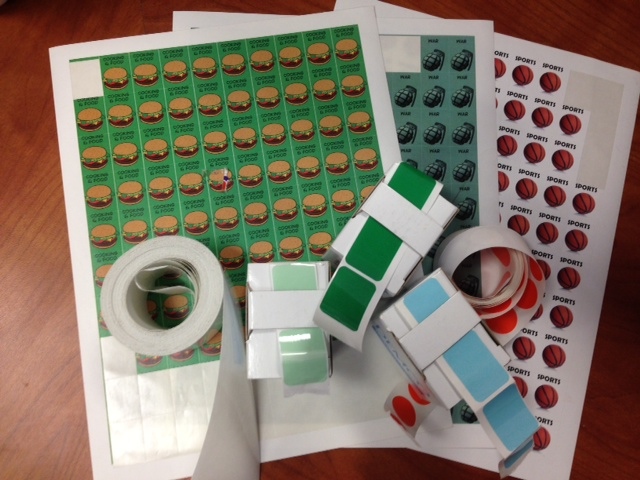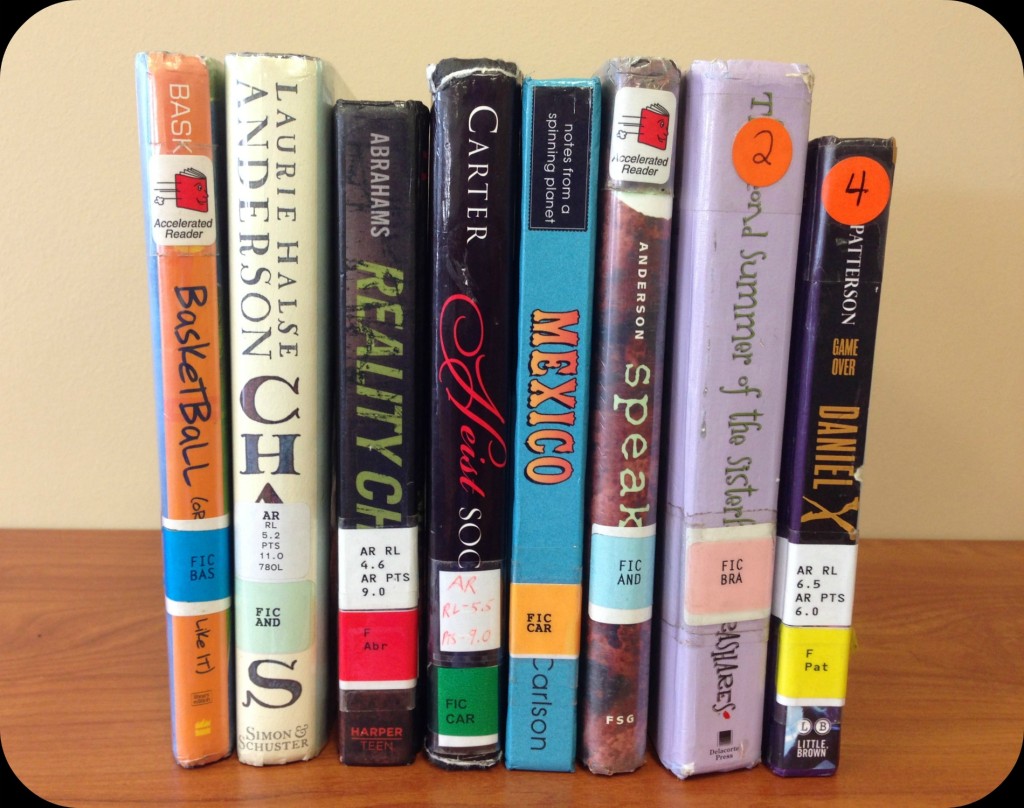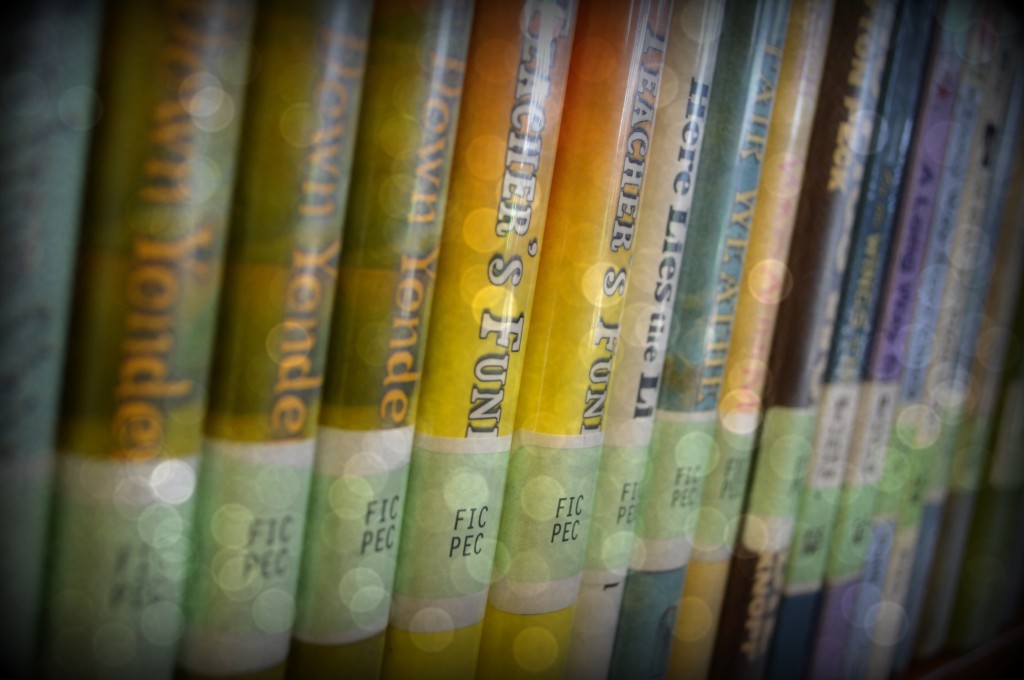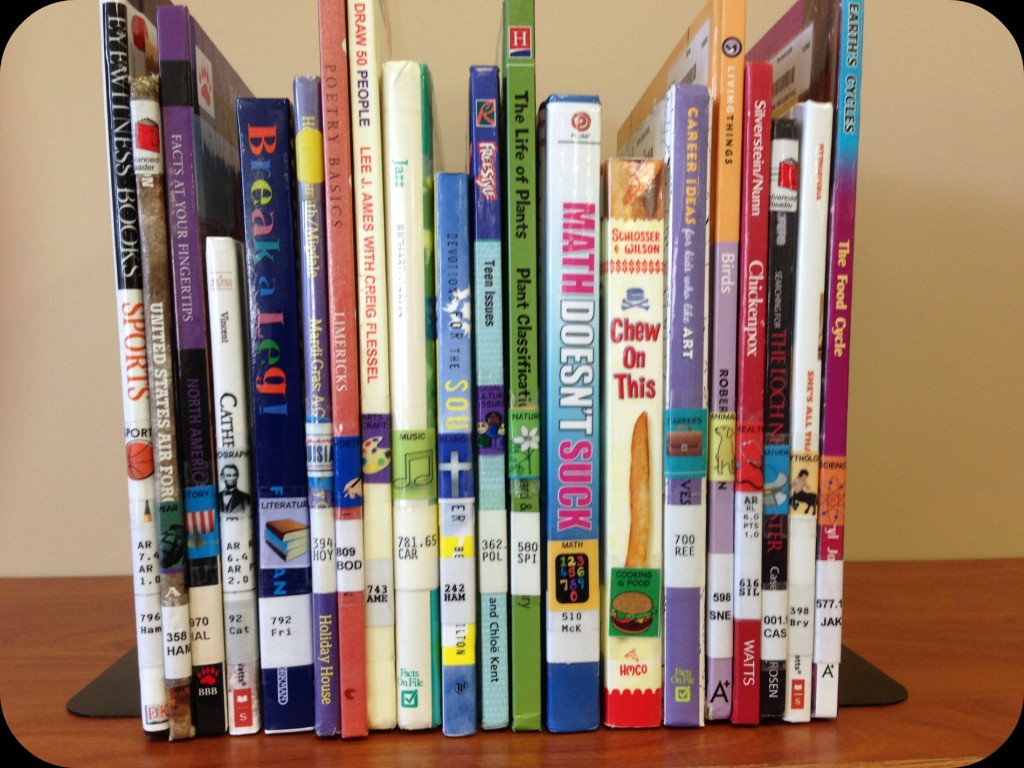The labeling of your books is a key part of the genrefication process. Think long and hard when deciding what labels you want to use…you’ll be looking at them for many years to come! 
I’m very happy with the choices I made for labels!
For our fiction books, I purchased Demco Color-Tinted Glossy Label Protectors to go over the spine labels. I love this look, because when I look at a fiction section, all of the books are labeled with the same color, so it’s very easy to see a book that’s in the wrong section.
Doesn’t that look nice?!
These are samples of books from my eight fiction genres:
 Did you notice the orange dots at the top of some of the books? That’s how we mark our series books.
Did you notice the orange dots at the top of some of the books? That’s how we mark our series books.
So once I had my genres decided and my stickers ready to go, I started at the beginning. I went book by book through my fiction section and evaluated. When I started this process, I was brand new to the library. And it needed some serious weeding. I spent many weeks weeding and tagging my way through the fiction section. It was a long and tedious process, but I’m so glad I did it (and did it myself). Whenever I had a little bit of spare time, I grabbed my box of tinted labels and went to work. I would look at the subjects on the copyright pages, read summaries, refer to the catalog, or talk to students who had read the book to decide on their genres. Instead of focusing more on the technicalities of the particular genres, I tried to think more in terms of, “What type of reader would be most likely to enjoy this book?” By working my way through the fiction section, weeding and genre tagging, I got to know my collection very well!
I approached nonfiction a little differently. First I weeded…SERIOUS weeding. That shrunk the size of my collection significantly. Then I sorted and tagged nonfiction. Obviously, sorting from Dewey into categories wasn’t that difficult. But it did make me SO HAPPY to put the pets and other animals in a section together. It made me even happier to move those darn military vehicles in with the war books. And I had a plan for arranging fiction and nonfiction sections near each other…which wasn’t happening with Dewey. But more on that later!
I created my own labels for the nonfiction categories. I had tons and tons of these spine label sheets, I used graphics from OpenClipArt.org, and I put the designs together in Comic Life. All of the labels that I’ve created can be found here on my Flickr account, free for you to use if you’d like! Here’s how they look on the books:
This is where I admit that I’m a label/tape snob. Back at my first library, I made new spine labels for lots of books and covered them with whatever label protectors I had lying around. MISTAKE! They all fell off. So I got in touch with Demco and they sent me samples of all of their label protectors. Now, I exclusively use Demco’s Ultra-Agressive Glossy Label Protectors. And those go over the top of EVERYTHING. And it stays put!
It would be much easier to go through the labeling process over the summer, with all of the books in the library. Of course, that’s not what I did! It took quite a while to work through this process as I continued to tag books as they were returned. But eventually, they were all properly labeled and ready for the next step…
Next up is “Making the Move!”


I’m interested in the genrefication idea, thanks for sharing. My own particular library quirk…spine labels in the same place on each book (bottom of label ~1/2″ from bottom of book spine). Looks neater and makes skimming the shelf for a particular call # much easier.
Just a couple of questions:
1) you chose the tape and said they were all the same color (as in the first photo). That all fiction was the same color… But the genre colors are different colors, right? So not all fiction are the same color, just the same “type” of colored label, right?
2) did you just assign a color to each genre instead of the genre type for the fiction spines?
3) as you were labeling, were you also adding a “future” location/sublocation/call number designation tag in the record?
4) will you ultimately mix fiction and non-fiction? Should the genres be similar to make that transition easier? Thoughts?
I can see how just going by each shelf and labeling and designating would be a little easier than tackling everything at once… Little by little!!!
Thank you so much for your feedback!! I really enjoy these updates and thank you for taking the time to post your process… At this point, I am the only librarian in our district of 32 considering this shift!!
Laurie
Thanks so much for the details! I am making the move in non-fiction in my K-3rd library! I’m trying to get some details together (like labeling) then I’ll jump in and work on it as I can. Once I commit to an idea, I just can’t wait! Your posts and links have been so helpful! Thanks for sharing!
Hello! I came across your website as a newbie sorting out our school library. Since working in the library is not my main job at the school, I want to create a simple and quick system of categorizing and labeling our books.
Do you think it’s possible to print spine labels (last initial of author for fiction books, category icon for NF) on paper and then attach them to the books using label protectors? Or something like this: http://www.gresswell.co.uk/colour-tinted-glossy-label-protectors.html
Or is it imperative to print the info onto a sticker to insure that they do stay on? Thank you for your help!
Hi Kari!
I’ve had issues with stickers falling off, so I would be nervous to just print on paper. Investing in good quality/super sticky stickers is more important that one would think…at least in my book. I am devoted to Demco’s Ultra Agressive Label Protectors…they are tried and true for me!
What size do you use for the Demco’s Ultra Agressive Label?
I use 1 1/2 x 3 1/4, but a little shorter would work, too.
Hi Tiffany,
Thanks for sharing your experience and wisdom! I am also in the process of reorganizing our picture book collection to a subject-based organization. Since the categories reflect our curriculum and top-circulating subjects, I’m having trouble finding labels that would fit with our situation. So, like you, I’m also interested in creating our own labels. Can you tell me a bit more about how you made the labels in ComicLife? Did you import the template? Or create the label image and then copy and paste it back into the template in Word?
Thank you in advance, and bravo on the awesome work!
I just used Comic Life to create the jpeg images (using the graphics from OpenClipArt.com), then put them into the template in Word to print the stickers. Best wishes to you genrefy your books!
I am having a lot of trouble getting the images I created in ComicLife to print on the template. I can’t make the image take up the whole label on the template. How did you do that? Your labels are gorgeous!
I met you and listened to all of your sessions at the 2015 AAIM conference in Hot Springs, Arkansas a couple of week ago. I am working to get all of my materials together to start the process of “genreficating” my library this summer. I was wondering what size label protectors did you order from Demco?
For the label protectors, I use the ones that are 1.5 x 3.25 inches. It gives enough overlap so they really STICK without being too huge.
That is exactly what is wrong with libraries today. There is an inherent assumption that all library patrons are too stupid to understand Dewey or how to use the catalog so we need to sticker a book so much that the title is no longer visible but hey there’s a genre sticker on it so everyone is happy. You know what works better, signage. Amazing how it works for book stores but somehow we have to sticker everything because it makes more sense? I’m willing to bet you still have to show people where everything is at in you library.
I am currently about to start changing my high school library to genre shelving. Initially I had the same misgivings as you, Jennifer…are we ‘dumbing down’ kids by not teaching them Dewey – making it too easy for them, doing everything for them? But then I thought about what my reason for changing was… What was the outcome I am after? Easy answer…I want kids reading books. Speaking with my own kids, who are quite shy and too afraid to ask for help from librarians, they quickly answered that they like to be able to find a book themselves. If they had to ask for help, they would rather not even get a book. If changing to genre shelving means that a child can more easily find a book they want to read; if it helps a reluctant reader leave the library with a book – or once they find a genre they like, they can easily find more of the same, then hey…that’s an outcome I like…kids reading books!
I agree…it’s all about getting the books in the right hands. Everything else is secondary!
Wow just reading this now and can’t believe how harsh this person who wrote above is. I genrified my old library and am working on genrifying the new library. I must say that librarians who decide to genrify typically do not think that patrons are too stupid to figure something out. Genrifying is about making the library more user friendly. Before I genrified, my patrons were always asking where all the science fiction books were or all the scary books. Genrifying was a real time saver for me and my students.
Anaastasia
librariantiff…I want to do something similar with the sports section and reluctant reader books.
Did you alter the call number in the automation system that you use? So when someone goes to the OPAC and looks up where to locate the book the call number actually says SPORTS F COY for example.
Yes! Check out this post on catalog changes — http://www.mightylittlelibrarian.com/?p=1059
Hi.
I’m hoping you can help me. I’m not a librarian, I am a reader. I just had the spine of a book mended with bookbinding (cloth) tape. What do you recommend I do for a spine label? I’ve been on the internet for a couple of hours and am more than ready for the advice of a pro.
Thank you so much!
J
What size of the Demco Color-Tinted Glossy Label Protectors did you use? I’m interested in organizing our elementary library by genre and your information is great!!
Thanks!
You’ve given me the courage to take this next step. THANKS!! I noticed in your pictures that you still have the Dewey call number on your NF books, in addition to an image spine label. Some of the categories I want to combine have different dewey numbers. Animals, for ex. Some are 500 and some are 600. Do they all just go in the “animal” sections, regardless of the call number? In that case, is the dewey call number obsolete? I plan to go into Destiny and change to call numbers to fit. Something like Nf/ANI – dogs – BAR (Non-fiction/animals – dogs – author last name) Can you add a little more detail as to how you handled call numbers?
Hi! I got to hear you speak today and was so excited because I have followed you for a while. Would you be willing to share what size den I color tinted label you used?
Hi Shay! I order the 7/8 x 1 1/4 tinted labels from Demco.
Hi. I am not a librarian. Am a volunteer in an orphanage trying to get the kids in that children’s home hooked to reading in English (Their mother tongue is not English). They are eager and are just about getting over the fear to attempt speaking in English. There are over 100 kids here and I thought setting up a small library in-house will encourage them to pick out books more frequently and gradually make them all readers. Am just about beginning the process. Have been collecting books from neighbors and friends who are donating a variety of books for a range of age group. This place cannot afford a computer system or a librarian. The kids have to manage it on their own. I plan to train a bunch of older kids (ages 12 to 15) on how to set up and run the library. We have just begun making an index of all the books coming in. I would like some guidance on how to catalog, label and display them. As I said this is an orphanage that has no help and I am not a librarian. So any guidance will be greatly appreciated.
Try LibraryThing. It’s a free, online library cataloging system for personal or small library use. It’s very easy to use; I just cataloged about 70 books on it, which took less than 3 hours. Most of the fields regarding the books information are filled in for you when you enter a book, and you can keep track of where a book is, if it’s checked out, etc.
I realize this is late in coming and may no longer be applicable to your situation, but I hope it might be helpful anyway.
I am currently weeding my library, starting with fiction. There are a few advanced picture books in the Fiction section. I want to make a section that is fiction picture books. More advanced than our Easy reading section (i.e. Older than 2nd grade), but separate because they are still picture books. What do you recommend for the spine labels for these books? My current are FIC XXX (XXX = author). I’d like to add another code above the FIC to differentiate these picture books. Any thoughts would be helpful!
Hi, this is a VERY boring question, but I am hoping someone can help. I am the librarian for 4 libraries. We have students ages 5-21 years old. At one of my libraries, we need new spine labels for the whole collection. I know we can make them ourselves in Alexandria, but I am wondering if anyone knows of a company to whom we can send our collection/titles and zap – they will print them up for us. Any help you can give me will be greatly appreciate. Thank you
I’m not sure about this. I use Follett, and if I were looking to do this I would contact them about the easiest way to go about it. Perhaps Alexandria could offer similar advice?
I’m a librarian at a school in Alabama. With the growing trend of books written in verse, I’m commonly having students ask for these kinds of books. Do you separate your novels in verse or label them in any particular way? Looking for a solution since they’re not marked in our catalog and are virtually impossible to search for!
I work in a small school library where all grades (pre-k through 12) all share the same library. We got rid of AR and went to the Lexile Level but do not like how it overlaps in the numbers for each grade level.
We have color coded labels to help separate depending on the Lexile level but the children feel like they are stuck in that color and can’t venture out.
What is the best way to go about color coding. So if an advanced 5th grader wants to read a 6th or 7th grade level book, they can just go do that instead of having to stay in their own level.
My color-coding is by genre, not by level. You can check out this position statement from ALA about leveling books: http://www.ala.org/aasl/advocacy/resources/statements/labeling
I find that once students reach middle school, forcing them into a reading level does far more harm than good — just let them read what they enjoy!
I am new to libraries, having owned a bookstore for 20 years and then teaching for 6. I currently am director of library resources for 5 public libraries, the third in this position in 5 years. The staff has gone from using genre labels to having to tear them all off. Not knowing this, I brought up the subject, thinking using them would benefit the patrons. Some were happy, others were NOT. Do you think it is important that all 5 libraries do the same thing when it comes to labels? One branch wants to get very specific, such as using Thrillers, Suspense, Mystery, Horror, and Cozy Mystery. One just wants Mystery if they have to use stickers. I am in the middle thinking Thrillers, Mystery, Cozy Mystery, but could be swayed. I know the ultimate decision is mine, but I would appreciate outside suggestions. Also, how is it best decided to chose the sub-genre? Money IS an object for us. Thank you.